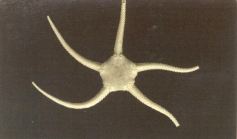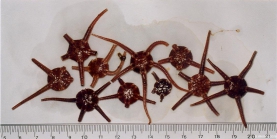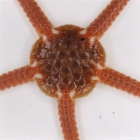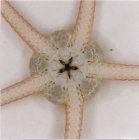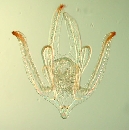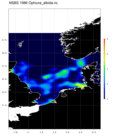Scheldt species taxon details
Ophiura albida Forbes, 1839
124913 (urn:lsid:marinespecies.org:taxname:124913)
accepted
Species
marine, brackish, fresh, terrestrial
Forbes, E. (1839). On the Asteriadae of the Irish Sea. <em>Memoirs of the Wernerian Society.</em> 8: 114-143., available online at https://www.biodiversitylibrary.org/page/35485580
page(s): 125 [details]
page(s): 125 [details]
Stöhr, S.; O’Hara, T.; Thuy, B. (Eds) (2021). World Ophiuroidea Database. Ophiura albida Forbes, 1839. Accessed through: VLIZ Consortium Scheldt Species Register at: https://www.scheldemonitor.org/speciesregister/aphia.php?p=taxdetails&id=124913 on 2025-09-11
VLIZ Consortium. Scheldt Species Register. Ophiura albida Forbes, 1839. Accessed at: https://www.scheldemonitor.org/speciesregister/aphia.php?p=taxdetails&id=124913 on 2025-09-11
Date
action
by
original description
Forbes, E. (1839). On the Asteriadae of the Irish Sea. <em>Memoirs of the Wernerian Society.</em> 8: 114-143., available online at https://www.biodiversitylibrary.org/page/35485580
page(s): 125 [details]
context source (Deepsea) Intergovernmental Oceanographic Commission (IOC) of UNESCO. The Ocean Biogeographic Information System (OBIS), available online at http://www.iobis.org/ [details]
context source (Schelde) MWTL biological monitoring network Westerschelde [MWTL biologisch monitoring netwerk Westerschelde] [details]
context source (BeRMS 2020) Bio-environmental research group; Institute of Agricultural and Fisheries research (ILVO), Belgium; (2015): Epibenthos and demersal fish monitoring data in function of wind energy development in the Belgian part of the North Sea. [details]
basis of record Hansson, H.G. (2001). Echinodermata, <B><I>in</I></B>: Costello, M.J. <i>et al.</i> (Ed.) (2001). <i>European register of marine species: a check-list of the marine species in Europe and a bibliography of guides to their identification. Collection Patrimoines Naturels,</i>. 50: pp. 336-351. (look up in IMIS) [details]
additional source Southward, E.C.; Campbell, A.C. (2006). [Echinoderms: keys and notes for the identification of British species]. <i>Synopses of the British fauna (new series)</i>, 56. Field Studies Council: Shrewsbury, UK. ISBN 1-85153-269-2. 272 pp. (look up in IMIS) [details]
additional source Muller, Y. (2004). Faune et flore du littoral du Nord, du Pas-de-Calais et de la Belgique: inventaire. [Coastal fauna and flora of the Nord, Pas-de-Calais and Belgium: inventory]. <em>Commission Régionale de Biologie Région Nord Pas-de-Calais: France.</em> 307 pp., available online at http://www.vliz.be/imisdocs/publications/145561.pdf [details]
additional source Hansson, H. G. (1998). NEAT (North East Atlantic Taxa): Scandinavian Echinodermata Check-List (Comp.). , available online at https://www.gu.se/sites/default/files/2020-10/NEAT%2AEchinodermata.pdf [details]
page(s): 125 [details]
context source (Deepsea) Intergovernmental Oceanographic Commission (IOC) of UNESCO. The Ocean Biogeographic Information System (OBIS), available online at http://www.iobis.org/ [details]
context source (Schelde) MWTL biological monitoring network Westerschelde [MWTL biologisch monitoring netwerk Westerschelde] [details]
context source (BeRMS 2020) Bio-environmental research group; Institute of Agricultural and Fisheries research (ILVO), Belgium; (2015): Epibenthos and demersal fish monitoring data in function of wind energy development in the Belgian part of the North Sea. [details]
basis of record Hansson, H.G. (2001). Echinodermata, <B><I>in</I></B>: Costello, M.J. <i>et al.</i> (Ed.) (2001). <i>European register of marine species: a check-list of the marine species in Europe and a bibliography of guides to their identification. Collection Patrimoines Naturels,</i>. 50: pp. 336-351. (look up in IMIS) [details]
additional source Southward, E.C.; Campbell, A.C. (2006). [Echinoderms: keys and notes for the identification of British species]. <i>Synopses of the British fauna (new series)</i>, 56. Field Studies Council: Shrewsbury, UK. ISBN 1-85153-269-2. 272 pp. (look up in IMIS) [details]
additional source Muller, Y. (2004). Faune et flore du littoral du Nord, du Pas-de-Calais et de la Belgique: inventaire. [Coastal fauna and flora of the Nord, Pas-de-Calais and Belgium: inventory]. <em>Commission Régionale de Biologie Région Nord Pas-de-Calais: France.</em> 307 pp., available online at http://www.vliz.be/imisdocs/publications/145561.pdf [details]
additional source Hansson, H. G. (1998). NEAT (North East Atlantic Taxa): Scandinavian Echinodermata Check-List (Comp.). , available online at https://www.gu.se/sites/default/files/2020-10/NEAT%2AEchinodermata.pdf [details]
 Present
Present  Inaccurate
Inaccurate  Introduced: alien
Introduced: alien  Containing type locality
Containing type locality
| Language | Name | |
|---|---|---|
| Dutch | kleine slangster | [details] |
| English | Serpent's table brittlestarbrittlestar | [details] |
BIOTIC
Encyclopedia of Marine Life of Britain and Ireland
Marine Life Information Network - UK
PlanktonNet Image
To Barcode of Life (52 barcodes)
To Biodiversity Heritage Library (121 publications)
To Dyntaxa
To European Nucleotide Archive, ENA (Ophiura albida)
To GenBank (42 nucleotides; 64 proteins)
To Global Biotic Interactions (GloBI)
To NHMUK collection (Ophiura albida Forbes, 1839; NON-TYPE; NHMUK:ecatalogue:9473836)
To PESI
To The Arctic Traits Database (18 traits)
To USNM Invertebrate Zoology Echinodermata Collection (9 records)
To ITIS
Encyclopedia of Marine Life of Britain and Ireland
Marine Life Information Network - UK
PlanktonNet Image
To Barcode of Life (52 barcodes)
To Biodiversity Heritage Library (121 publications)
To Dyntaxa
To European Nucleotide Archive, ENA (Ophiura albida)
To GenBank (42 nucleotides; 64 proteins)
To Global Biotic Interactions (GloBI)
To NHMUK collection (Ophiura albida Forbes, 1839; NON-TYPE; NHMUK:ecatalogue:9473836)
To PESI
To The Arctic Traits Database (18 traits)
To USNM Invertebrate Zoology Echinodermata Collection (9 records)
To ITIS

